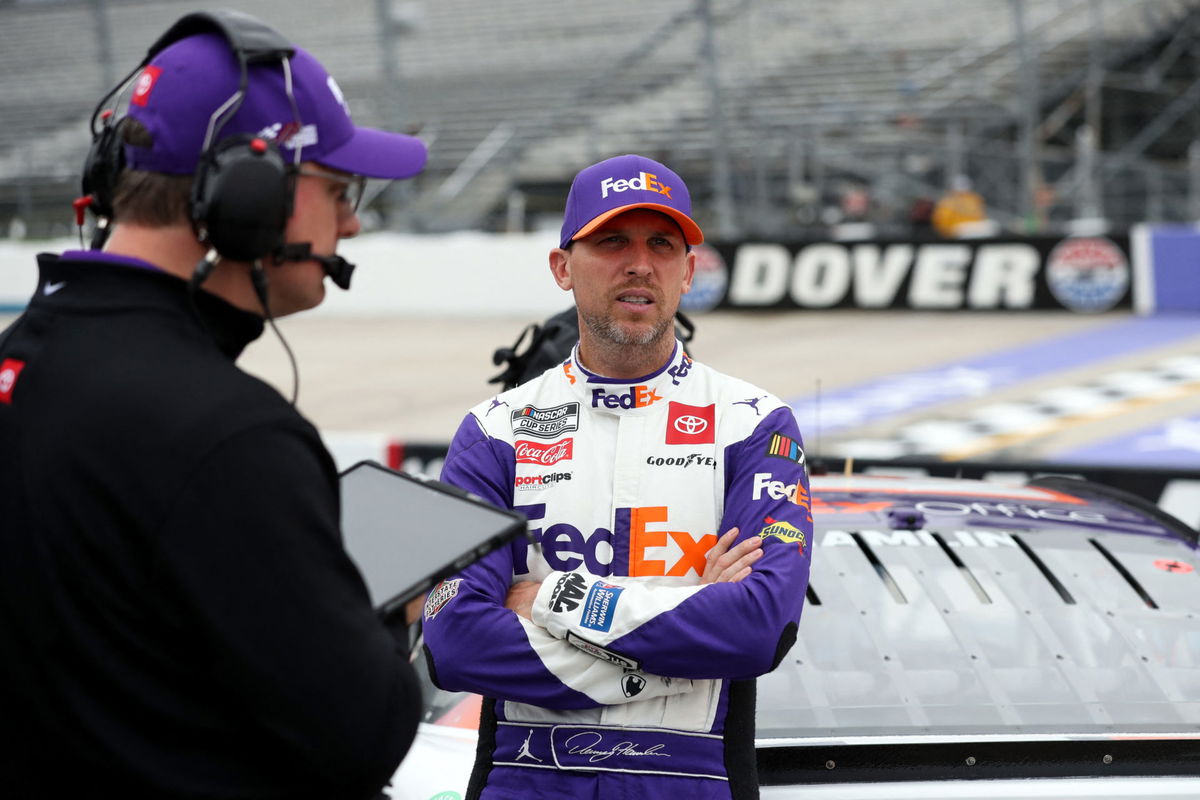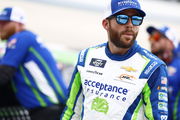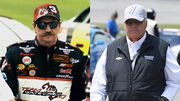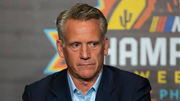
USA Today via Reuters
Apr 29, 2023; Dover, Delaware, USA; NASCAR Cup Series driver Denny Hamlin stands with his crew chief Chris Gabehart (left) during practice and qualifying for the Wurth 400 at Dover Motor Speedway. Mandatory Credit: Matthew OHaren-USA TODAY Sports

USA Today via Reuters
Apr 29, 2023; Dover, Delaware, USA; NASCAR Cup Series driver Denny Hamlin stands with his crew chief Chris Gabehart (left) during practice and qualifying for the Wurth 400 at Dover Motor Speedway. Mandatory Credit: Matthew OHaren-USA TODAY Sports
There’s no external element in motorsport that can make or break a driver’s race quite like the pit stop. Whether it’s Brad Keselowski’s infamous run-in with his pit-crew in 2015 during the Windows 10 400 at Pocono or Kevin Harvick’s pit fire in 2003, NASCAR pit crews have had to overcome all sorts of obstacles to deliver fast pit stops. After all, what matters the most is those crucial seconds saved by managing a pit stop efficiently.
Watch What’s Trending Now!
So when the NASCAR next-gen car was introduced, it was only fitting for Joe Gibbs Racing to perfect the pit stop, leading to a documentary on their pit crew coming out only a few days ago on January 19. Produced by WinShape Teams, ‘Chasing Faster: The Next Gen Pit’ took fans on a wild ride that gave the community great insight into the secrets behind Coach Gibbs’ pitstop dominance. Let’s take a look at some of the notable revelations made by key figures.
ADVERTISEMENT
Every pit stop is a risk vs reward assessment: Chris Gabehart
While it’s no secret that Denny Hamlin is a great driver worthy of his Cup Series success, the Crew Chief of his #11 Car, Christopher Gabehart, feels it would not have been possible without the crew behind him. After all, no matter how many cars Hamlin overtakes on the track, if he loses out during the pit stop, it would have all been in vain. After all, even the caution flag is vital to the outcome of track position if a driver undertakes a pit stop, so it’s safe to say a lot is riding on the pit crew.
Gabehart shared in the documentary, “Every pit stop is a risk vs reward assessment for everyone involved. Right down to me and the engineers as to what adjustments we’re gonna call on the car and how much it will slow the pit stop down.” When pit stops first began, they were hardly a factor accounted for when considering areas of improvement.
But over the years, crew chiefs like Ray Evernham realized that the pit crew must perform like any other squad of athletes. He shared the various factors that the crew must now account for now. “His (the driver’s) rolling speeds down pit road, is he able to optimize the track and gain every foot that he can? The driver is only as good as the team underneath him, only as good as the pit crew’s ability to get him out front with a shot to win,” the NASCAR insider said.
ADVERTISEMENT
ADVERTISEMENT
Not only are pit crews now trained athletes with their own tailor-made regiments to deliver the best results, but the team monitoring their progress has seen equal strides in innovation. Gone are the days when pit crews would just eyeball the timing. With state-of-the-art cameras and sensors, teams are now able to extract as much data as possible to improve in every aspect.
WATCH THIS STORY: The $75,000 Legacy – Dale Earnhardt’s priceless memorabilia
ADVERTISEMENT
However, it isn’t just technical innovation that drives the pit crew forward. The JGR crew went on to reflect on the importance of individual chemistry between team members and how it could make or break the race result.
Top Stories
Ross Chastain Labels NASCAR Driver “The Most Punchable Face” to Excuse Himself Over Punchgate Controversy

Jimmie Johnson Poaches Richard Childress’ Key Ally Ahead of NASCAR 2026 Season

When Rick Hendrick Walked Away From $1,000 to Avoid Dale Earnhardt Sr’s Wrath

NASCAR’s Next Big Villain Named as Denny Hamlin Enters Fans’ Good Books

Commissioner Steve Phelps Quits NASCAR Days After Getting Exposed in Lawsuit Trial

Teamwork makes the dream work
Lindsay Jones, the head athletic trainer at Joe Gibbs Racing also shared a similar opinion as the #11’s crew chief. She shared that the team’s chemistry with each other was more important than individual performance. Even if a team member is great on paper, if they can’t gel well with the team, it’s no good for anyone involved.
ADVERTISEMENT
She stated, “Team chemistry is very trial and error because you have a lot of new people that might not know each other. You have some people that do know each other, but just on pit road, casually. I’ve seen it so many times when one person on a team, even if they’re performing well, is affecting the team end game by just being that guy.” And she was not the only one of the opinion that the pit crew’s psyche mattered more than technology.
ADVERTISEMENT
Christopher Gabehart himself chimed in to share that at the end of the day, a pit crew comprised of human beings needed to interact with one another. Without social interactions building a strong foundation, the pit crew could forget to deliver record-breaking pit stops. He concluded, “If that chemistry isn’t there, it just won’t work at a high level, and if it’s not working at the very highest level, you won’t win.”
ADVERTISEMENT
Not only did the documentary give us great insight into the functioning of a pit crew and how the Next Gen car has transformed the way teams approach pit stops, but it also opened a lot of eyes that failed to realise how vital the tyre-changing army is. With that being said, have you caught up with the Chasing Faster documentary yet?
ADVERTISEMENT
ADVERTISEMENT
ADVERTISEMENT

